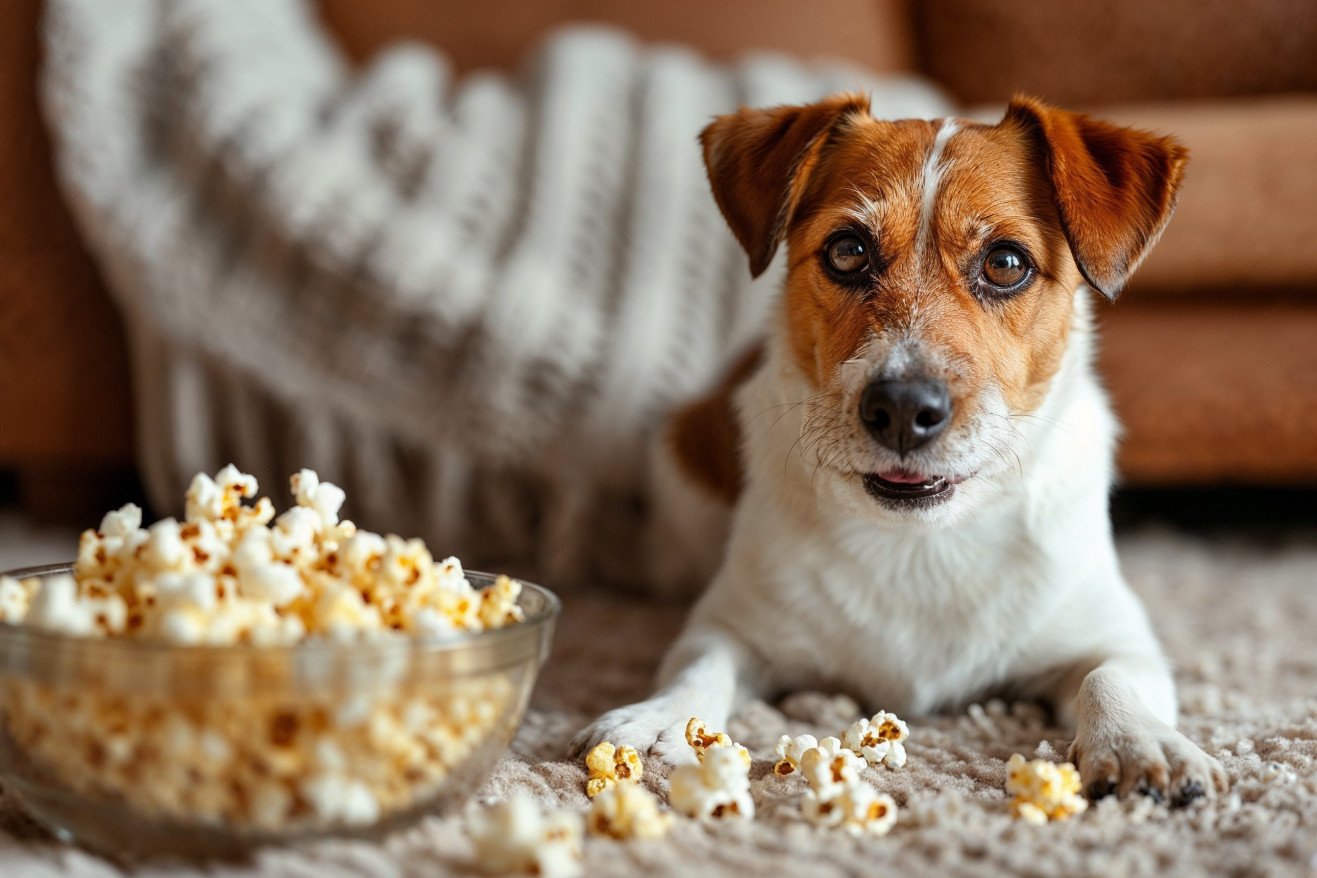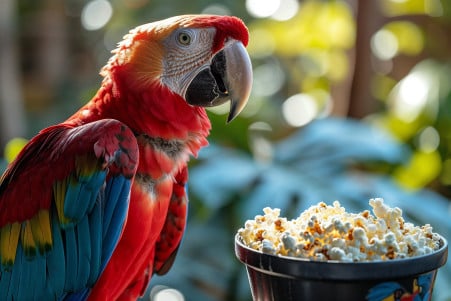Can Dogs Eat Popcorn? Safe Snacking Guidelines for Your Pooch
23 January 2024 • Updated 28 January 2024

If you have a dog, you’ve probably shared your snacks with them at some point. But what about popcorn? Dogs can eat plain, air-popped popcorn in moderation. However, it should not contain any butter, salt, or other toppings.
It’s also important to make sure that there are no unpopped kernels in the popcorn, as these can be a choking hazard. In general, treats like popcorn should make up no more than 10% of a dog’s daily caloric intake.
To learn more about the potential benefits and risks of giving your dog popcorn, let’s take a closer look at the most recent research from veterinarians and the nutritional content of popcorn.
We’ll also discuss the potential downsides and benefits of different types of popcorn and the importance of dietary fiber in a dog’s diet. By the end of this article, you’ll have a better understanding of the factors to consider when choosing popcorn for your dog, so you can make the best choice for their health and happiness.
Can dogs eat popcorn?
Nutritional Value of Popcorn for Dogs
When given in moderation and without any unhealthy toppings, popcorn can be a nutritious snack for dogs because it is a whole grain. According to Healthline, air-popped popcorn is naturally high in fiber and contains important vitamins and antioxidants, like B vitamins. These nutrients can help with digestion and even weight control due to popcorn’s low energy density.
That said, if popcorn is covered in butter, salt, sugar, or caramel, it can lose its nutritional value for dogs and lead to obesity and other health problems. The ASPCA warns that dogs need a balanced diet and recommends that no more than 10% of a dog’s daily caloric intake come from treats like popcorn to avoid nutritional deficiencies and weight gain.
It’s important to remember that popcorn should be given to dogs in moderation as a treat. If dogs eat too much popcorn, they may consume too many calories and not enough of the nutrients they need from their regular diet. By understanding where popcorn fits into a dog’s diet, pet parents can make sure their dogs can enjoy popcorn without sacrificing their health.
Which Types of Popcorn Are Safe for Dogs?
Not all popcorn is created equal when it comes to giving it to your dog. Air-popped popcorn is the safest choice because it doesn’t contain the added fats, salts, and sugars that can be harmful to your dog. In contrast, microwave popcorn can be problematic because of the chemicals that are used in the lining of the bags.
In fact, a study by UCLA Health found that people who ate microwave popcorn had higher levels of PFAS in their bodies. PFAS are chemicals that are known for being both environmentally persistent and having potential health effects.
Theater-style popcorn is also problematic because of its high fat and sodium content, which isn’t healthy for dogs. In fact, Verywell Health explains that these types of popcorn can be high in saturated fat and sodium, which can lead to health issues like high blood pressure and heart disease in people, and the same is true for dogs.
To make sure that you’re not putting your dog at risk, only give them plain, air-popped popcorn. Make sure that you pop it completely so that there aren’t any hard kernels that could be a choking hazard or damage your dog’s teeth. Don’t add any seasonings, and make sure that you only give it to your dog in moderation as part of a balanced diet.
Understanding How Cooking Affects the Nutritional Content of Popcorn
The way we cook our food can have a big impact on its nutritional content. While cooking can make some nutrients more available, Healthline explains that it can also lead to a loss of vitamins and minerals. This means that when it comes to popcorn, the way it’s prepared can impact whether or not it’s safe for dogs to eat.
Air-popping, which doesn’t use oil or other fats, is a healthier option for both people and dogs. On the other hand, microwave popcorn is often made with added fats and other ingredients that can reduce its nutritional value, which may make it unsafe for dogs to eat.
A study published in PMC even found that the high temperatures used to cook food in a microwave can lead to a loss of omega-3 fatty acids, which are essential for dogs.
Meanwhile, steaming is a cooking method that doesn’t lead to a loss of water-soluble vitamins and is a healthier way to cook food. While steaming isn’t a method used to cook popcorn, the fact that it doesn’t lead to a loss of most nutrients, according to a study published in PMC, shows how important cooking methods can be when it comes to maintaining the nutritional content of food.
For dog owners who want to give their pets popcorn, air-popping is the best way to prepare it. Air-popping doesn’t lead to a loss of the popcorn’s nutrients or the addition of potentially harmful ingredients, so it ensures the popcorn will be safe for dogs. When you consider the role of treats in a dog’s diet, the importance of dietary fiber, especially from sources like popcorn, becomes clear in terms of supporting digestive health.
Fiber’s Impact on Canine Health
Fiber has a number of important impacts on canine health, including aiding in digestion and helping to manage weight. As explained by The Dog Food Advisor, fiberwhich is only found in the cell wall of plantshelps ensure regular bowel movements and can help treat constipation and diarrhea in dogs.
Fiber fermentation in the colon also results in the production of short-chain fatty acids, which can help with colonic repair and even reduce the risk of cancer.
The American Kennel Club, which cites information from The Farmer’s Dog, notes that while fiber is important for a well-rounded diet, too much fiber can lead to problems like gas and bloating, so it’s important to make sure your dog’s fiber intake is in check. To avoid overdoing it, it’s recommended that no more than 10% of a dog’s daily caloric intake come from high-fiber treats like plain air-popped popcorn.
If you want to give your dog high-fiber treats like popcorn, it’s important to be mindful of how you do so. According to Purina, this means gradually introducing high-fiber treats and making sure that the total fiber content in their diet doesn’t exceed the recommended 2.5 to 4.5 percent. This way, dog owners can ensure their pets get the benefits of fiber in terms of digestion and weight management while still maintaining a nutritionally complete diet.
Popping Popcorn for Pooches: How to Feed Your Dog Popcorn Safely
The right amount of popcorn to feed your dog will depend on their size and weight. For example, a small dog can have a few pieces of plain, air-popped popcorn, while a larger dog can have a little more.
However, you should still start with a small amount and work your way up while keeping an eye out for any signs of digestive issues or allergies, such as itching or an upset stomach, according to Readers Digest.
If your dog does have a sensitivity to popcorn, there are other healthy treats you can try, like carrots, green beans, or dog treats made for sensitive stomachs and allergies, such as PureBites Beef Liver or Zuke’s Mini Naturals.
Make sure the popcorn you feed your dog is free of unhealthy additives like butter, salt, and especially xylitol, a sweetener that’s poisonous to dogs.
For more personalized advice that takes your dog’s specific health needs into account, talk to a vet, whose knowledge is indispensable. A vet can work with you to come up with a diet that includes treats in a healthy way, so you can make sure your furry friend’s snacks are both safe and satisfying.
Summing It Up: Can Dogs Eat Popcorn?
So, in conclusion, when it comes to dogs and popcorn, plain, air-popped popcorn can be a safe and fun treat for your dog in moderation. Vets, as mentioned by PetMD and Purina, recommend that treats make up no more than 10% of your dog’s daily caloric intake and that they are free of potentially dangerous additives.
Popcorn’s high fiber content can also be a healthy addition to your dog’s diet when fed in moderation, and it can help with digestive health. That said, the dangers of buttered, salted, and sweetened popcorn, which can lead to digestive upset and obesity, are a good reason to keep it simple when sharing this snack.
As pet parents, our pets’ health is our top priority. While popcorn can be a fun treat, it’s up to us to make sure our dogs are eating a nutritionally balanced diet and are healthy.


